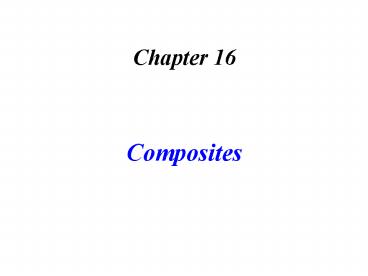Composites - PowerPoint PPT Presentation
1 / 26
Title:
Composites
Description:
Many of modern technologies require materials with unusual combination of ... by eutectic solidification. --Glass w/SiC fibers. formed by glass slurry ... – PowerPoint PPT presentation
Number of Views:146
Avg rating:3.0/5.0
Title: Composites
1
Chapter 16
- Composites
2
Introduction
- Many of modern technologies require materials
with unusual combination of properties that
cannot be met with conventional metal alloys,
ceramics, and polymeric materials (Aerospace,
underwater, transportation). - Composite Any multiphase material (artificially
made) that exhibits a significant proportion of
the properties of both constituent phases such
that a better combination of properties is
realized. - Constituent materials must be chemically
dissimilar and separated by a distinct interface
(Metallic alloys and ceramics do not fit the
definition).
3
Introduction (Cont.)
- Many composite materials are composed of two
phases Matrix (Continuous medium surrounding the
other phase) Dispersed phase. - Properties of composites are a function of
- Properties of constituent phases.
- Relative amounts of constituents.
- Geometry of dispersed phases (shape of particles
and particle size, distribution, and
orientation).
4
Terminology/Classification
Composites --Multiphase material
w/significant proportions of each phase.
Matrix --The continuous phase
--Purpose is to transfer stress to
other phases protect phases from
environment --Classification MMC, CMC, PMC
metal
ceramic
polymer
Dispersed phase --Purpose enhance matrix
properties. MMC increase sy, TS, creep
resist. CMC increase Kc PMC
increase E, sy, TS, creep resist.
5
(No Transcript)
6
(No Transcript)
7
(1) Particle-reinforced composites
- Types
- Large particle composites
- Concrete (cement matrix and sand and gravel
particulates). - Cermets (ceramic metal composites)
- Dispersion-strengthened composites (10-100 nm).
- Dispersed phase is harder and stiffer than the
matrix (it restrains movement of the matrix phase
in the vicinity of each particle. - For dispersion strengthened composites, phase
Strengthening is retained at elevated
temperatures and for extended time periods
(relative to precipitation hardened alloys).
8
Particle-reinforced
Examples
9
Particle-reinforced
Elastic modulus, Ec, of composites -- two
approaches.
Application to other properties --
Electrical conductivity, se Replace E by se.
-- Thermal conductivity, k Replace E by k.
10
(No Transcript)
11
(2) Fiber reinforced composites
- The most important composites.
- Design goals High strength and/or stiffness on a
weight basis (i.e., specific strength and
specific modulus). - Mechanical characteristics depend on
- Fiber and matrix properties
- Degree to which an applied load is transmitted to
the fibers by the matrix phase (depending on
fiber orientation and arrangement) , - Phase volume fractions
- Direction of load application.
12
Various fiber orientation and arrangement
13
(No Transcript)
14
(No Transcript)
15
Fiber-reinforced
Aligned Continuous fibers
Examples
--Metal g'(Ni3Al)-a(Mo) by eutectic
solidification.
--Glass w/SiC fibers formed by glass slurry
Eglass 76GPa ESiC 400GPa.
(a)
(b)
16
Fiber-reinforced
Discontinuous, random 2D fibers
Example Carbon-Carbon --process
fiber/pitch, then burn out at up to
2500C. --uses disk brakes, gas
turbine exhaust flaps, nose cones.
(b)
(a)
Other variations --Discontinuous, random
3D --Discontinuous, 1D
17
Fiber reinforced composites (Cont.)
- Some critical fiber length ( gt 1 mm) is needed
for effective strengthening and stiffness of the
composite material. - Fibers classification (based on diameter and
character) - Whiskers (very thin single crystal, extremely
large length-to-diameter ratios, virtually flaw
free, very high strength, expensive). - Fibers (polycrystalline or amorphous materials
having small diameters). - Wires (having large diameters).
18
(No Transcript)
19
(No Transcript)
20
(No Transcript)
21
Structural
Stacked and bonded fiber-reinforced sheets
-- stacking sequence e.g., 0/90 -- benefit
balanced, in-plane stiffness
Sandwich panels -- low density, honeycomb
core -- benefit small weight, large bending
stiffness
22
(No Transcript)
23
Composite benefits
CMCs Increased toughness
PMCs Increased E/r
MMCs Increased creep
resistance
24
(No Transcript)
25
(No Transcript)
26
Summary
Composites are classified according to --
the matrix material (CMC, MMC, PMC) -- the
reinforcement geometry (particles, fibers,
layers). Composites enhance matrix
properties -- MMC enhance sy, TS, creep
performance -- CMC enhance Kc -- PMC
enhance E, sy, TS, creep performance
Particulate-reinforced -- Properties are
isotropic. Fiber-reinforced -- Properties
can be isotropic or anisotropic. Structural
-- Based on build-up of sandwiches in layered
form.































